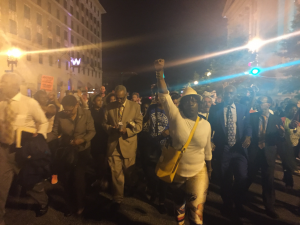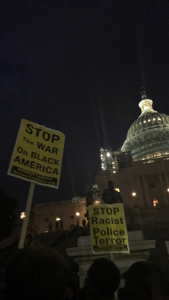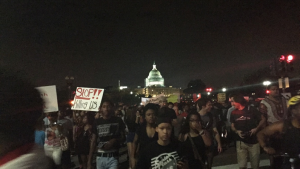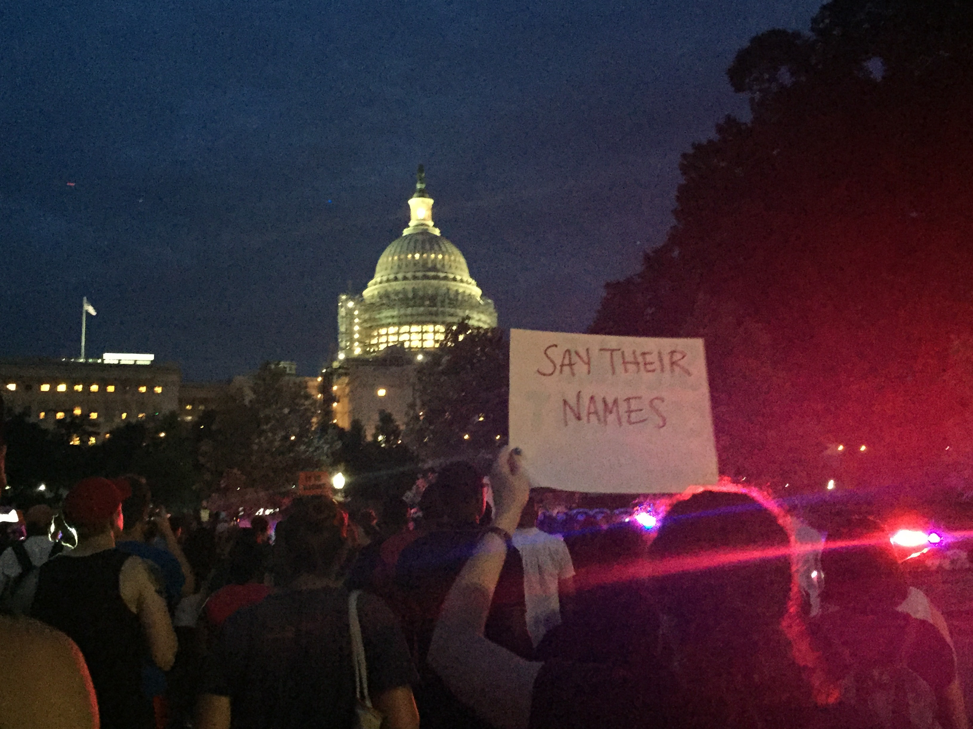Last week, the deaths of Alton Sterling and Philando Castille sent shockwaves across the country. By the night of Thursday, July 7, people in the nation’s major cities were gathering to protest police brutality.
“I think the word to describe it is grief. Loss, and everyone’s just reeling,” said Desiree Joy Frias, an organizer of a protest that marched from the Department of Justice to the White House on Friday. “They can’t handle hearing that another person was murdered 24 hours after someone was murdered. It’s just, it’s too much. It’s just too much.”
Thursday and Friday evenings in the heart of Washington, DC saw peaceful protests: protestors were orderly and considerate of each other, and while police presence was constant and noticeable, there were no altercations and few, if any, arrests.
On Thursday night, the protestors had assembled outside the White House at around 8 pm before marching to the US Capitol building. The march flowed down Pennsylvania Avenue, passing the U.S. Archives, the Newseum, the Department of Justice, and the Trump Tower Hotel.
The call to end police brutality has been linked with civil rights conversations for decades. From images of water hoses being sprayed on demonstrators in the 1960s to the recent deaths of Freddie Gray, Michael Brown, and others, this problem is not new.
Black Lives Matter (BLM) started in 2013 after the trial of George Zimmerman, who shot and killed 17 year-old Trayvon Martin in Sanford, Florida. The movement is known for its use of protests against cases in which African Americans are killed by police.
“A lot of people say that protesting isn’t doing anything, but it’s a first step. So, going forward, the hope is that protesting will, that at least this protest, create further change…and could be the start of something bigger,” said Hakeem Mlwlana, who participated in Friday’s protest in Washington D.C.

Despite its use of peaceful protests, the movement can be divisive. BLM seems to be plagued by many different ideological segments. For outsiders, it can be hard to understand the central message of the movement at times.
“The biggest thing is that when we say black lives matter, we don’t mean that only black lives matter. When we say black lives matter, we mean black lives matter too. Because obviously that’s not appearing in our current justice system and our current society,” said Mlwana.
Forty members of Congress came out to talk to protestors in D.C. that Thursday night, including Georgia Congressman John Lewis — a hero of the civil rights movement and the congressional moral compass. Again, the organizer tried to quiet the crowd, asking them for respect as Lewis addressed the protesters.
“I went to jail 40 times during the ‘60s. Beaten, left bloody, and unconscious, and I never gave up,” Lewis said.
The congressman was interrupted many times by protestors in the crowd.
“Y’all do your job!” yelled one protestor as Lewis began to speak. Others began to murmur similar sentiments.
The protest organizers moved to hush these impertinent voices: “They’re trying to do their job, give them respect. Let them talk, they’re trying to do their job. They’re out here for a reason.” said one organizer “They care. These people care.”
“I went to jail 40 times during the ‘60s. Beaten, left bloody, and unconscious, and I never gave up.” – Congressman John Lewis
Many protestors, like the crowd at Thursday’s march to the Capitol, seek solutions through encouraging politicians to work towards reforming institutions of government. But others in the movement seem to have distrust for government and believe the solution is to dismantle many of the United States’ current systems.
It is a newfangled reality of our current political climate on many issues—people do not trust their government or elected officials. This is one reason why political outsiders like Donald Trump and Bernie Sanders were able to gain so much traction against establishment politicians this election cycle.
In a time when every political issue seems more polarized than at any time in U.S. history, it is natural that the Black Lives Matter movement would have a similar sentiment. Radical voices are worthy of respect — they can shift dialogues in a productive way.

Despite all of the peaceful protesting that occurred Thursday night in places like DC, New York City, Atlanta, and Los Angeles, they were mostly overshadowed when a gunman shot 10 police officers during a protest in Dallas.
It seems that, despite all the immense efforts of BLM and other movements that seek to end police brutality, this image of violent protests cannot be shaken. Despite peaceful demonstration after peaceful demonstration, it’s places like Ferguson, Baltimore and now Dallas that have become associated with BLM.
The Black Lives Matter movement and the nation will have to address these concerns of organized violence if they become a trend. The fight against police brutality is one that cannot be won in a climate of fear; fear will only deepen these wounds rather than heal them.
As our nation grapples with how to face its demons in these times of unrest, it is important to remember the peaceful protests that occurred in the previous week.
Friday, the nation’s eyes were fixed on Georgia as demonstrators in Atlanta met resistance from law enforcement near the Downtown Connector. Protestors and police alike remained peaceful yet firm.
Three people were arrested that night. Three — out of a crowd of 10,000, in a city whose history is scarred by decades of racism and oppression, that was destroyed by war, that rose from ashes and unrest to become known as “the city too busy to hate”.
Addressing protestors, Atlanta mayor Kasim Reed said, “[the protest was] about being the best version of ourselves”.
The night before, in D.C., thousands of protestors stood at the steps of the U.S. Capitol as legislators tried to talk over the hum of the crowd. The crowd soon began to urge members of Congress to join them in their march. Protestors began chanting, “lead the way”.
It is often easy in turbulent times to find a reason to be mad, to rail against a common enemy. Perhaps the most difficult decision in these times is to instead find solutions, to ask others for help in solving problems too big for one person or group to solve. Americans must work together to find a solution to this setback.

“The problem does not fall on the shoulders only of African Americans, it falls on all Americans. That’s how we’re such a great country: because we’ve usually joined together in war and peace to make a difference.” said Congresswoman Sheila Jackson Lee of Texas after Thursday’s protest.
The first step to solving a problem is to admit that there is one. Perhaps the next is to reach out and offer respect and understanding to those who can help. The important question is how Americans will react when offered the chance for change.
“You say you want us to march with you,” said one member of Congress to the protestors, “Well, where are we gonna go?”
